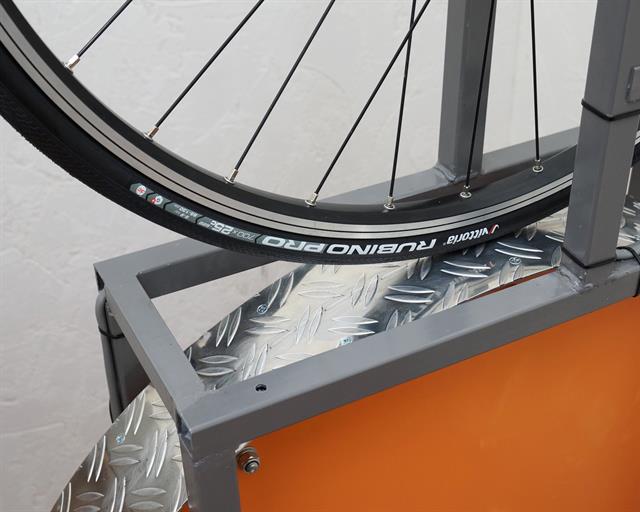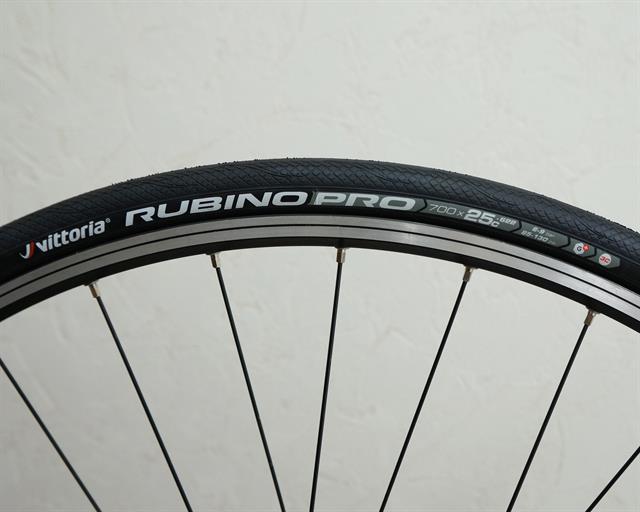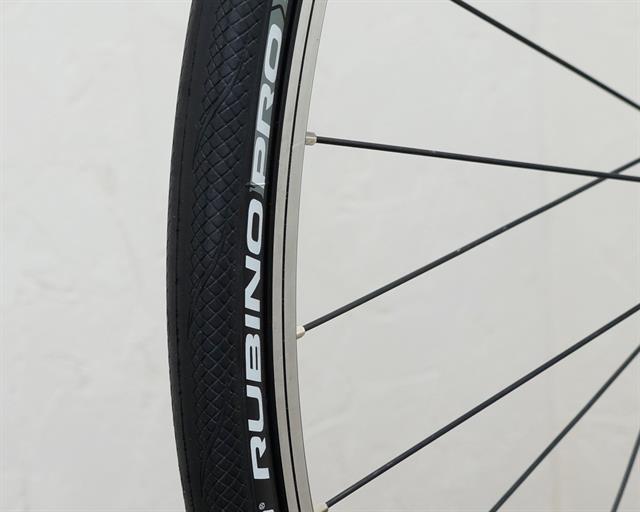Road Bike Tire Test: Vittoria Rubino Pro G+ 1.0 25
Contents and Test Summary
- Introduction
- Manufacturer Specifications
- Size, Weight, Thickness
- Rolling Resistance: 14.8 Watts
- Puncture Resistance: 57 Points
- Static Wet Grip: No Data
- Conclusion: 3.0 / 5 Recommended
- Comments
- Vittoria Rubino Pro G+ 1.0 25
(100% is best)

NOTE: We have a test available of a newer version of this tire: Vittoria Rubino Pro G+ 2.0 2019
The Vittoria Rubino Pro G+ is the successor of the popular Rubino Pro III. The Pro III was one of my favorite tires because it offered a low rolling resistance and a decent puncture resistance at a low price. On paper, the new Rubino Pro G+ offers some improvements over its predecessor. The biggest improvement is the use of a new triple graphene G+ compound which according to Vittoria is the biggest improvement in bicycle tire-tech in years.
Together with the new Rubino Pro G+, Vittoria also released a new G+ Rubino non-Pro, Rubino Pro Speed, Rubino Pro Control and Rubino Pro Endurance. The Pro Speed and Pro Control seem like the most interesting tires. The Pro Speed (read review) offers a lower weight and a lower rolling resistance at the cost of decreased puncture resistance. The Pro Control (read review) offers a better puncture resistance at the cost of a higher weight and higher rolling resistance.
When comparing the Rubino Pro G+ to its main competitors, it seems to have an advantage with the use of a triple compound rubber. Most other tires in this price range offer a single compound or at most a dual compound. It looks like Vittoria is still using the same 150 TPI carcass with an extra layer of puncture resistance material under the tread. A good opportunity to see if the new 3C G+ compound really has a lower rolling resistance.
Manufacturer Specifications
| Manufacturer Specifications | |
|---|---|
| Brand | Vittoria |
| Model | Rubino Pro G+ 1.0 |
| Year | 2016 |
| Tire Type | Tubetype (clincher) |
| Supplied By | Bought in store |
| New or Used | New |
| Mileage | 0 km |
| Price Range | Med |
| Buy At | |
| Manufacturer part number | 111.3RB.21.25.111BX |
| EAN | 8022530001946 |
| TPI | 150 |
| Compound | 3C G+ |
| Bead | Folding |
| ETRTO | 25-622 |
| Size Inch | 28" |
| Specified Width (mm) | 25 |
| Specified Weight | 235 grams |
| Max Air Pressure (psi) | 130 |
| Made In | Members Only |
| Available Sizes |
23-622 (700x23C) 25-622 (700x25C) 28-622 (700x28C) 23-571 (650x23C) |
Vittoria Rubino Pro G+ 1.0 25 Test Results

Size, Weight, and Thickness Measurements
| Size, Weight and Thickness Measurements | |
|---|---|
| Specified Weight | 235 grams |
| Measured Weight | 248 grams |
| System Adjusted Weight (tire + inner tube (100 gr) |
348 grams |
| Measured Width | 26 mm (un-round) |
| Measured Height | 23 mm (un-round) |
| Total Tire Thickness Center | 3 mm |
| Total Tire Thickness Sidewall | Members Only |
| Unmounted Casing Width | 63 mm |
| Unmounted Tread Width | Members Only |
| Tread Cover (Tread / Casing Ratio) | Members Only |
| All size measurements are taken at an air pressure of 100 psi / 6.9 bars on a 17.8 mm inner width rim. | |
Specified weight is unchanged at 235 grams when compared to the Pro III. I've measured my sample at 248 grams which is quite a bit more. The old Pro III came in at 238 grams. Measured width on a 17C rim at an air pressure of 100 psi is 26 mm, height is 24 mm.
At the center of the tire, the Rubino Pro G+ has a total thickness of 3.0 mm, this is a slight decrease when compared to the older Rubino Pro which came in at 3.2 mm. A decrease of the total thickness indicates there is slightly less rubber to wear down. The sidewalls have a thickness of 0.55 mm which is the same as the older version.
Rolling Resistance Test Results
| Rolling Resistance Test Results | |
|---|---|
| Inner Tube | Conti Race28 (100gr butyl) |
| Measured Width | 26 mm (un-round) |
| Rolling Resistance Real tire width in mm: 22-24 = 132 psi/9.1 bar 25-27 = 120 psi/8.3 bar 28-29 = 108 psi/7.4 barUltra High Air Pressure (120 psi / 8.3 bar) |
14.8 Watts CRR: 0.00444 |
| Rolling Resistance Real tire width in mm: 22-24 = 110 psi/7.6bar 25-27 = 100 psi/6.9 bar 28-29 = 90 psi/6.2 barExtra High Air Pressure (100 psi / 6.9 bar) |
16.0 Watts CRR: 0.00480 |
| Rolling Resistance Real tire width in mm: 22-24 = 88 psi/6.1 bar 25-27 = 80 psi/5.5 bar 28-29 = 72 psi/5.0 barHigh Air Pressure (80 psi / 5.5 bar) |
Members Only |
| Rolling Resistance Real tire width in mm: 22-24 = 66 psi/4.6 bar 25-27 = 60 psi/4.1 bar 28-29 = 54 psi/3.7 barMedium Air Pressure (60 psi / 4.1 bar) |
Members Only |
| The Road Bike section is a multi tire size section, air pressures have been adjusted to the measured casing width. All numbers are for a single tire at a speed of 29 km/h / 18 mph and a load of 42.5 kg / 94 lbs. Use the formula: RR (Watts) = CRR * speed (m/s) * load (N) to calculate rolling resistance at a given speed and load. |
|
Unfortunately, I can't say the Rubino Pro G+ performs very strong in the rolling resistance test. Rolling resistance is OK, but the bad thing is rolling resistance has increased when compared to the older Pro III. The old Pro III was a great tire with a very low rolling resistance for its price. The new G+ Rubino Pro still performs decent for a medium priced tire, but the difference has gotten smaller when compared to other tires in the same price range.
What surprises me the most is that rolling resistance of the G+ increases much faster when dropping air pressure. At the very high air pressure of 120 psi, rolling resistance is 1.4 watts higher when compared to the old Pro III. At the very low air pressure of 60 psi, rolling resistance of the new Rubino Pro G+ is 3.7 watts higher. The 3C compound really doesn't help to achieve a lower rolling resistance.
Puncture Resistance Test Results

| Puncture Resistance Test Results (higher is better) | |
|---|---|
| Total Puncture Score Tread | 57 Points |
| Total Puncture Score Sidewall | Members Only |
| Tread Puncture Force Sharp Needle | 12 Points |
| Tread Puncture Force Blunt Needle | No Data |
| Tread Total Tire Thickness | 3 mm |
| Sidewall Puncture Force Sharp Needle | Members Only |
| Sidewall Puncture Force Blunt Needle | No Data |
| Sidewall Total Tire Thickness | Members Only |
Puncture resistance of the tread area is still 12 points, which is an average score for an all-round road bike tire with a single layer of puncture resistance material. Puncture resistance of the sidewalls has decreased from 7 points to 5 points. The 2 points difference seems big, but this is amplified by the rounding of the scores. Unrounded scores came in at 5.8 for the new G+ and 7.2 for the old Pro III. I'll look into a smaller rounding for the sidewall PR scores.
Static Grip Test Results
NOTE: Grip test data is only available on tires tested after November 2018. You can find more information about our grip test here: Introducing Grip Testing
| Static Grip Test Results | |
|---|---|
| Wet Grip Average | No Data |
| Wet Grip Center | No Data |
| Wet Grip Edge | No Data |
| Grip in points = coefficient of friction * 100 Road bike grip test rim width = 19.0 mm |
|
Conclusion
- Vittoria Rubino Pro G+ 1.0 25
(100% is best)
There has been a lot of talk about the new Vittoria G+ tires. Vittoria claims the use of graphene results in tires that offer a lower rolling resistance, higher puncture resistance, more grip and longer life. I can confirm rolling resistance and puncture resistance hasn't gotten any better with the new Rubino Pro G+. It's possible the new triple compound used on the Rubino Pro G+ was optimized more towards grip and longer life at the cost of RR. Time will tell if that's true when the first real-world experiences come in.
If you're looking for a fast and light Rubino style tire and don't mind a low puncture resistance, the new Rubino Pro Speed G+ (read review) is a much faster tire than the Pro G+. In the medium price range, the Continental Grand Prix (read review) with the single compound BlackChili rubber now seems to be the best choice with a low rolling resistance and decent puncture resistance.
RATING:
3.0
/ 5
TEST VERDICT:
Recommended
